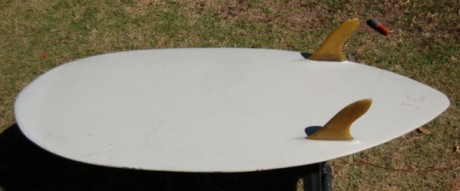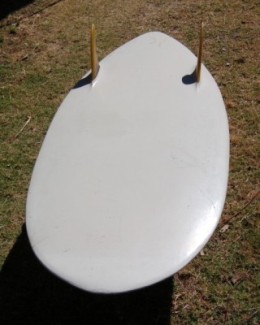Dr. Barry Hutchins Paipo Interview
November 30, 2009. Perth, Western Australia
Questions and e-Mail Interview by Bob Green

Barry Hutchins riding at Yallingup, WA. Photo by: Clay Bryce.
1. How did you come to start making bellyboards? When was the first one?
I
always had rubber surfoplanes when I was growing up and regularly
visited Cronulla Beach with my family. I made my first bellyboard in
1963, after seeing surfers riding them at Cronulla. I was a student at
Newington College (at Stanmore near the city) so didn't know any of the
locals where I lived (at Caringbah). However, I was forced to leave
this school by my mother (the fees were too high) and I spent my last
year at Caringbah High where I met a group of body-surfers who surfed
at Cronulla Point. Thus in no time, I was a regular there. This first
board was made (crudely) from plywood and had no fins. It was three
feet long.
2. You've mentioned your first board was made from chipboard. How did it ride? Did it last long?
This
was actually my second board and it replaced the above board when it
delaminated. I painted the chipboard, but it still only lasted a few
months (started to swell). Once again it had no fins so was not very
manoeuvrable.
3. Where did you get the idea of riding bellyboards from? Had you ridden stand-up boards?
No,
I have never owned a stand-up board although I had given it a go on
borrowed boards, but never took to it (also the cost was a factor).
Bellyboards seemed a good compromise between body surfing and standup
boards.
4. Cronulla is a pretty localised area. What was the reaction of other surfers to you?
When
I started surfing at Cronulla Point, most of my friends were body
surfers. Stand-up surfers hated body surfers and bellyboarders so we
tended not to mix. I made my first redwood board on the recommendation
of my stepfather (who had built a few sailing dinghies from this wood).
The wood came in 12 inch wide planks and 1 inch thick. My stepfather
helped me glue and dowel the planks together and showed me how to
fibreglass the board after it had been shaped. I bought my supplies
from the local surfboard manufacturer (Jacko surfboards) where I hung
around picking up tips. I eventually bought a small booklet entitled
"How to build surfboards" which helped me a lot. My first redwood board
was three foot long and proved popular with some of the body-surfers
who asked me to make one for them. After making three or four, my
mother suggested that I should advertise in the free ads section of the
Sunday Telegraph. This I did and I got so many orders that I had to
hire a school friend to help me make them. By this stage, I was
supposed to be studying for my Leaving Certificate, but I somehow
always managed to be working on boards in the backyard shed instead. I
was hoping to get into Vet school at Sydney Uni (my mothers choice),
but my marks weren't good enough and so I had to do marine biology at
Uni of NSW. However, this was a move strongly supported by me as I had
always had a fascination for the ocean (my family moved to Sydney from
Griffith where my father had a farm when I was 9).
5. Who was the market for your boards?
Most
of the people who ordered boards from me were either body surfers or
new comers to surfing. A few good friends reordered as I came up with
better designs.
6. How long did you make boards for in Sydney? Did you stick with a basic design or was there much evolution?
A
redwood board would take about a week to complete but I was probably
working on more than one at a time (I remember that just before Christmas
1964, I had 8 boards on the go). When I started getting orders for
balsa boards, these were usually five feet long and required a redwood
stringer for strength. Thus they took longer to build and cost more to
purchase (18 pounds versus 12 pounds for the redwood boards). I built
one foam bellyboard, but I refused to do any more because of the large
amount of wastage (I had to start with a surfboard blank). Altogether I
made about forty boards, most of them to order. It all came to an end
when I finished my science degree and went into the army (I had been
called up for national service in 1966). I served with the infantry in
Vietnam where I was wounded, but left Sydney when I returned to
Australia in 1971, because of the hostility around at the time to
Vietnam vets. I worked on trawlers in Qld before heading to WA for a
wedding (a life-changing experience).
The long balsa versions of my belly boards were all made to order and I
believe the purchasers did use them occasionally for stand up surfing
(the first short boards?). The long central fin was the idea of
one purchaser, but I soon learnt that it was not highly manoeuvrable so
eventually dropped it. I did try triple fins of the high aspect
ratio shape, but came to the conclusion that two high aspect fins
were enough.
Figure
Set 1. All boards were made from 1 inch redwood in 1965, 4 foot long by
22 inches wide; the white one was my personal board for that year.
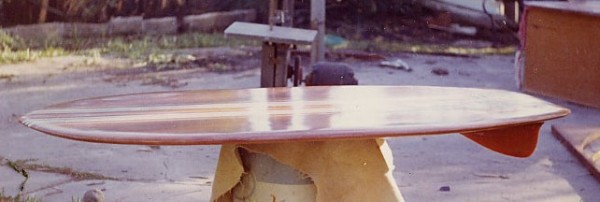


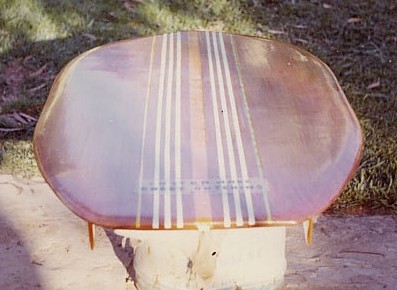
Regarding evolution, my early three foot redwood boards quickly turned
into four foot boards and eventually four foot three inches as the
longer boards were much faster. I explained earlier that I tried using
a step on the undersurface of the tail but gave this away shortly
after.
Note the step on the undersurface of the tail.
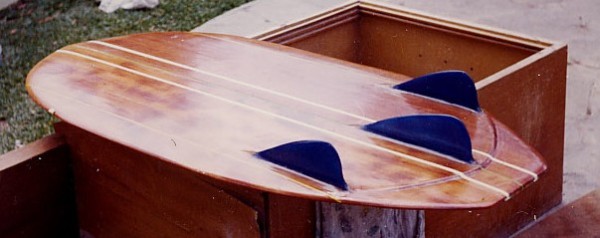
Figure Set 2.
2a. This is a 4 ft redwood board for another bellyboard
rider at Cronulla Point (1966).

2b. 4 ft redwood, dark blue (1965).
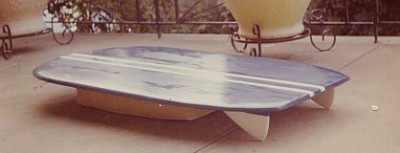
2c. My personal 4 ft board in 1965 before I added white
pigment coat (to cover up dings).
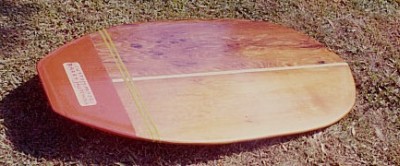
2d. 5ft balsa board (Xmas 1964).
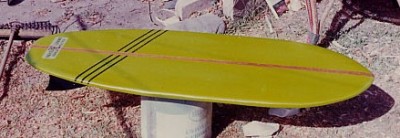
|
2f. 4 ft redwood board (Xmas 1964).
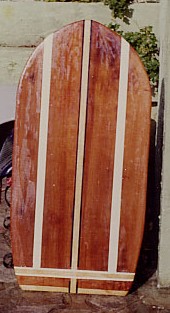
2g. 3 ft redwood board (1965).
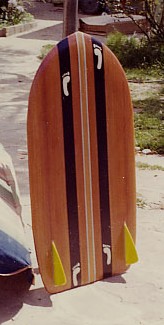 |
2e. 5ft balsa board (Xmas 1964).
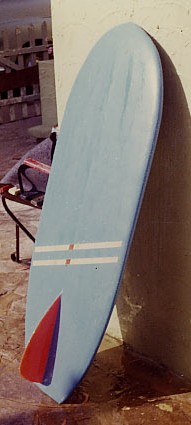
|
2h. 3ft redwood board (Xmas 1964).
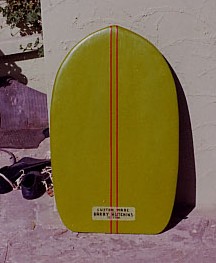
2i. 5ft balsa board (Xmas 1964).
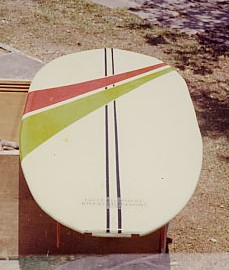
|
My last four or five boards were all pintails. All boards had
one layer of 10 oz fibreglass cloth on the undersurface, wrapping
around the rails. I made a few with glass on both surfaces but they
tended to be too heavy. At one stage, I could not get any redwood
planks, but was recommended by the timber yard to try Pacific Maple or
Queensland Mahogany. I tried both. The maple was good, almost as light
as redwood but the mahogany was a disaster, too difficult to shape and
far to heavy. I was embarrassed in having to sell a few boards made
from the latter wood.
You might have noticed my change in fin shapes, from low aspect to high
aspect fins. This occurred in 1965 and made the boards a lot more
manoeuvrable.
Figure Set 3. Barry's personal board built in 1966 from 1 inch redwood.
Regarding my riding style, I always tried to keep my weight forward as
this stopped the tail of the board dragging in the water and maximized
speed. However, it required it careful observation of the wave as too
much weight on the nose of the board in the wrong section of the wave
often led to a nosedive. You may have noticed on several boards that I
used a tail shape that incorporated a step in the surface. This was
supposed to reduce the wetted area when the rider moved his weight
forward. However, I never convinced myself that it was worth the effort
and stopped incorporating it in later boards.
7. Where have you surfed your boards? Any particular surfs or waves stand out? Was Shark Island surfed much in the 60s?
I
have surfed most locations on the south coast of NSW and when working
on a farm in Victoria (during Uni vacation), surfed at Torquay and
Bells Beach. I surfed a few areas on the north coastal beaches of
Sydney, but spent a fabulous week at Crescent Head in 1966 (made
enemies with many of the standup surfers by taking off way too far
inside). Shark Island was surfed occasionally on big days when the
waves broke a bit further off the rocks, but a number of my friends
wiped out on the reef and ended up in hospital so we tended to stick to
the point break. Another favourite spot on big days was Voodoo near
Kurnell. When I moved to Perth in 1972, I quickly found that the local
beaches only had small waves due to the shallow offshore reefs.
However, the conditions in the Margaret River and Yallingup areas were
some of the best in Australia. I made numerous trips down there to
surf, but had a momentous wipeout in 1974, at Yallingup going right, and
was trapped under a reef for far too long. This made me look at surfing
from a new perspective and resulted in me hanging up my bellyboard for
about ten years. Instead I concentrated on scuba-diving and
snorkelling, and except for a two year period riding waveskis, I have
not returned to surfing.
8. What sort of surfing/waves were your boards built for?
I tended to build my boards for the big waves that were common at Cronulla Point.
9. When you moved to West Australia in 1972, did you continue making boards?
No.
10.
Do you think a different board is required to surf Western Australia
compared to Sydney? If so, what sort of shape/design is required.
The
big waves down south are perfect for the big wave boards of NSW, but
around Perth, the light boogie board is far superior. There are some
big wave areas at Rottnest Island, but I have only surfed them once
with a bellyboard.
11. Epilogue.
Since
I gave up surfing, I have become a devoted sailor, having first
started in 1963 when I built a sailing plywood surfboard (12 ft), but
didn't get serious until the 1980's when I bought a 14 ft surf cat,
then an offshore 6 meter surf cat that I used as a dive boat, then a
7.2 meter trimaran that I bought in Qld and towed back to Perth on its
trailer, then a 10 meter cruising catamaran and now I have a 10.5 meter
catamaran that I built between 2003 and 2007 (see attached pic). I
still sail every week, mostly at Rottnest Island, but I have plans to
sail further afield (I have previously done trips to the Abrolhos
Islands and Shark Bay). Now that I am retired (and on an army invalid
pension), I have plenty of time up my sleeve. I could probably take up
bellyboarding again but it would always take a back seat to sailing and
diving.
|
Surfing at Garie Beach, south of Cronulla, probably in 1965.
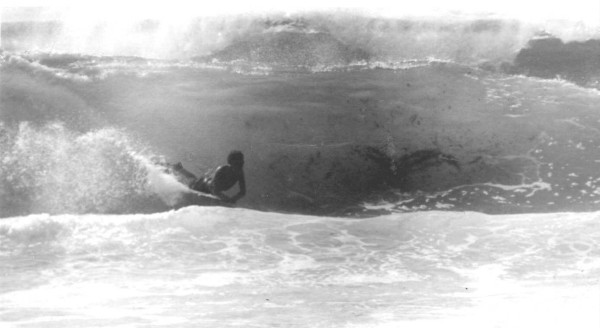
Photo by Rick Shapter.
|
|















